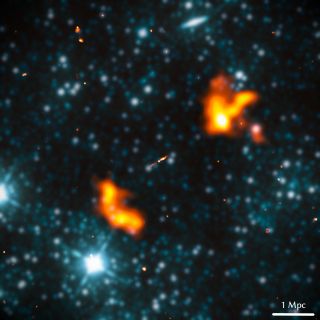James Webb Space Telescope Uncovers “Teenage” Galaxies in Cosmic Adolescence
The James Webb Space Telescope (JWST), operational since last year, has revealed groundbreaking insights into galaxies that could be considered the cosmic “teenagers.” Unlike the early galaxies observed, these entities, formed about 2-3 billion years post-Big Bang, show unique characteristics resembling teenage behavior – marked by growth spurts and a touch of immaturity.
Distinctive Traits of Cosmic Adolescents
Teenage galaxies, though already forming a substantial number of stars, exhibit a rapid growth phase. They differ significantly from contemporary galaxies and undergo crucial, yet poorly understood processes during this cosmic adolescence, shaping their future characteristics.
Temperature Anomalies in Stellar Nurseries
The study noted that the gas in star-forming regions within teenage galaxies was significantly hotter, reaching about 24,000 degrees Fahrenheit (13,350 degrees Celsius) compared to modern galaxies. This temperature anomaly suggests differences in the properties of young stars and gas in these cosmic adolescents.
Glowing Elements Illuminate Galactic Insights
Observations revealed the galaxies glowing with eight elements – hydrogen, helium, oxygen, nitrogen, sulfur, argon, nickel, and silicon. Oxygen, a key component in “galaxy DNA,” provides insights into past growth. The unexpected presence of glowing nickel may indicate unique properties in massive stars influencing gas luminescence.
The CECILIA Survey and Chemical Evolution
The study, part of the Chemical Evolution Constrained using Ionized Lines in Interstellar Aurorae (CECILIA) Survey, marks the JWST’s role in scrutinizing distant galaxies’ chemistry. The findings hint at a chemically “immature” phase in these galaxies, suggesting rapid ongoing formation.
JWST’s Contribution to Cosmic Understanding
Launched in 2021, the JWST has significantly expanded our understanding of the early universe. While attention often focuses on the telescope’s observations of the earliest galaxies, the CECILIA Survey demonstrates its ability to provide detailed insights into galaxies in later cosmic epochs.
Future Implications and Ongoing Research
The study underscores the potential for further discoveries as the JWST continues to unveil details about galaxies in various stages of cosmic evolution. This research offers a unique perspective on cosmic adolescence and contributes to unraveling the mysteries of galactic development.
Month: Current Affairs - November, 2023
Category: Science & Technology Current Affairs








